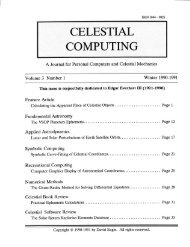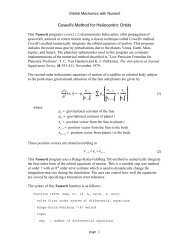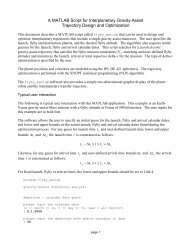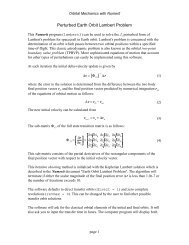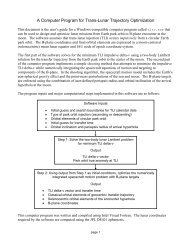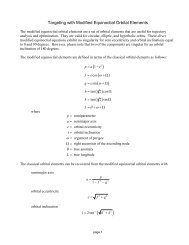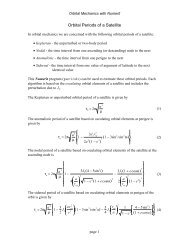The Circular Restricted Three-body Problem
The Circular Restricted Three-body Problem
The Circular Restricted Three-body Problem
- No tags were found...
You also want an ePaper? Increase the reach of your titles
YUMPU automatically turns print PDFs into web optimized ePapers that Google loves.
Celestial Computing with NumeritIn his prize memoir of 1772, Joseph-Louis Lagrange proved that there are fiveequilibrium points in the circular-restricted three-<strong>body</strong> problem. If we place a satellite orcelestial <strong>body</strong> at one of these points with zero initial velocity, it will stay therepermanently. <strong>The</strong>se special positions are also called libration points.For the Earth-Moon mass ratio value of , the x and y coordinates of these five equilibriumpoints L iare as follows:L 1 x = +0.836892919 y = 0L 2 x = +1.155699520 y = 0L 3 x = -1.005064520 y = 0L 4 x = +0.487844901 y = +0.866025404L 5 x = +0.487844901 y = +0.866025404<strong>Three</strong> of these libration points are on the x-axis and the other two form equilateraltriangles with the positions of the Earth and Moon.<strong>The</strong> program begins by asking you to select from 4 main program options. <strong>The</strong> first threeoptions will display typical periodic orbits about the respective libration point. <strong>The</strong> initialconditions for each of these orbits are as follows:(1) periodic orbit about the L 1libration point(2) periodic orbit about the L 2libration point(3) periodic orbit about the L 3libration pointx 0= 0.300000161y· 0 = −2.536145497µ = 0.012155092t f= 5.349501906x 0= 2.840829343y· 0 = −2.747640074µ = 0.012155085t f= 11.933318588x 0= −1.600000312y· 0 = 2.066174572µ = 0.012155092t f= 6.303856312page 2




